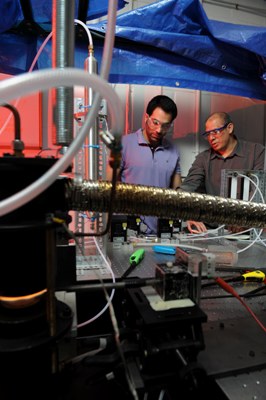Nov 2 2012
A new discovery by University of Oklahoma and North Carolina State University researchers shows a breakthrough in speeding up the process for synthesizing transition metal oxide nanostructures. What had once taken days can now be accomplished instantaneously.
 Moien Farmahini, a Ph.D. candidate in mechanical engineering, runs experiments with Merchán-Merchán in the lab on the University of Oklahoma Norman campus.
Moien Farmahini, a Ph.D. candidate in mechanical engineering, runs experiments with Merchán-Merchán in the lab on the University of Oklahoma Norman campus.
After previous success using an oxygen-enriched flame to synthesize common nanomaterials, such as carbon nanotubes, nanofibers and fullerenes, OU College of Engineering professor Wilson Merchán-Merchán and his team conducted experiments using the same method to create a new form of nanostructures. Instead of synthesizing the carbon nanomaterials, they discovered a method of creating 1-D and 3-D TMOs that have distinctive electronic and mechanical properties.
With a multi-year grant from the National Science Foundation, Merchán-Merchán and his research affiliates are exposing bulk transition metals to the hottest parts of an oxygen-enriched flame. From that reaction, high-demand transition metal-oxide nanostructures are instantaneously synthesized, including nanorods, hollow channels and hybrid nanowires and platelets.
Inexpensive and quick growth of TMOs means a better chance for large-scale synthesis and eventual common use in the marketplace. The potential for increased supply has led to increased experimentation on the capacity of TMOs, and the results show their effectiveness in a diverse range of applications.
"Recently, one-dimensional TMO naonostructures have attracted tremendous attention due to their applications in optics, medicine and electronics," Merchán-Merchán said. "For instance, the micron-sized channel structures with nanometer wall thickness contain slender, prismatic and completely hollow cavities that can be used in medical applications for drug delivery."
Most recently, this research team coated the surface of solar panels with one of their flame-formed tungsten oxide nanorods. The result was a 5 percent increase in the solar panel's efficiency, a large gain considering solar panels' notoriously low efficiency rating of 15 to 20 percent.
With endless applications and a new horizon of possibilities, Merchán-Merchán's research into TMOs is still in its infancy.
"The distinct shape and chemical composition of the flame-formed nanostructures may change the way many products are designed," Merchán-Merchán said.
"Our next steps are to expand the application of TMOs using flames, in a variety of markets ranging from solar panels to electrodes for penetrating biological tissues for drug delivery and electrodes in lithium-ion batteries."